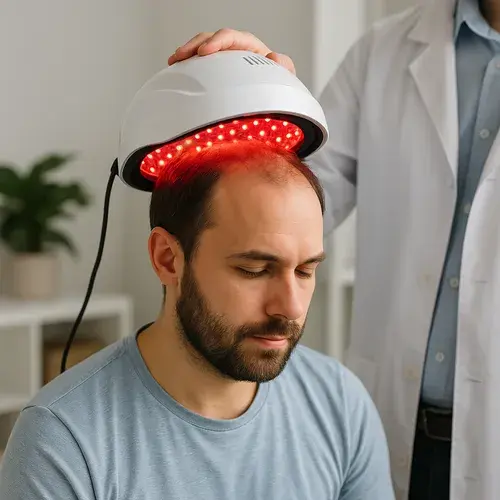Low-Level Laser Therapy for Hair Loss: How Laser Therapy Promotes Hair Growth Safely
Low-level laser therapy (LLLT) is a safe, non-invasive treatment that stimulates hair growth by enhancing scalp blood flow and metabolism, showing promise for androgenetic alopecia sufferers.

Low-level laser therapy (LLLT) has emerged as a promising treatment for hair loss, particularly for those suffering from androgenetic alopecia, also known as genetic baldness. This non-invasive, pain-free treatment involves the use of low-intensity laser or light-emitting diodes (LEDs) to stimulate hair growth. In this article, we will delve into how LLLT promotes hair growth safely and explore its effectiveness. What is Low-Level Laser Therapy? LLLT, also referred to as red light therapy or cold laser therapy, involves the application of low-intensity laser or LED light to the scalp. The photons emitted by these devices are absorbed by weak cells in the scalp, which can help stimulate hair growth. This treatment is designed to enhance blood flow and metabolic activity in the scalp, thereby encouraging hair follicles to produce new hair. The Science Behind LLLT The theory behind LLLT is that the low-dose laser treatments invigorate circulation and stimulate hair follicles. Hair growth occurs in three phases: the anagen phase (growth), telogen phase (resting), and catagen phase (shedding). In androgenetic alopecia, hair loss is often due to an increase in dihydrotestosterone (DHT), a testosterone derivative that can lead to hair follicle miniaturization. LLLT aims to increase blood flow and stimulate metabolism in catagen or telogen follicles, promoting the transition back to the anagen phase and resulting in new hair growth. Safety and Efficacy Numerous studies have shown that LLLT is safe and effective for promoting hair growth. A 2014 study found that low-level laser therapy appeared to be safe and effective for hair growth in both men and women . Another study conducted in 2013 observed a 39% increase in hair growth over a period of 16 weeks among male participants . The meta-analysis of randomized controlled trials included in a systematic review demonstrated a significant increase in hair density among those treated with LLLT compared to sham devices . How to Use LLLT Devices LLLT devices come in various forms, including handheld combs, helmets, and caps. These devices typically emit red or near-infrared light, which is absorbed by the scalp tissues. Users usually apply these devices for 15-30 minutes per session, several times a week. It is essential to follow the manufacturer's instructions and consult with a healthcare professional before starting any new treatment. Benefits and Limitations While LLLT has shown promise in promoting hair growth, it is not a cure for all types of hair loss. It is most effective for treating male pattern baldness and female pattern hair loss, as classified by the Norwood-Hamilton Classification for men and the Ludwig-Savin Scale for women . Some users may experience improvement within 12 to 26 weeks of use, with reduced hair fall and noticeable hair growth . However, results can vary, and more research is needed to fully understand its efficacy. Conclusion Low-level laser therapy offers a safe and non-invasive option for individuals seeking to promote hair growth. By enhancing blood flow and metabolic activity in the scalp, LLLT can stimulate hair follicles to produce new hair. While it is not a solution for everyone, especially those with severe hair loss, it has proven success in treating androgenetic alopecia. If you are considering LLLT as a treatment option, it is crucial to consult with a healthcare professional to determine if this therapy is right for you.
Need Professional Consultation?
Our professional doctors will provide detailed hair and scalp analysis and develop personalized treatment plans.
Book Consultation Now